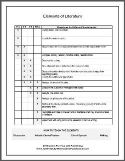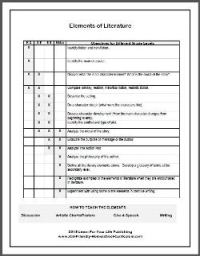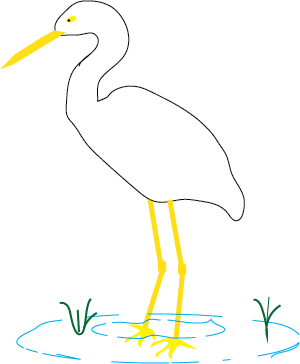
Elements of Literature
Your Guide to Teaching the Elements of Literature at Different Levels

FREE GUIDE: Educational Objectives for Literature
See below for free teaching guide.
Also below: 4 Ideas For Teaching Elements of Literature
Kindergarten to Second Grade
Teaching Simple Literary Elements for Early Readers
Children enjoy stories and talking about stories. Use these simple elements to help them verbalize the differences between various stories and think about their meaning.- Identify fiction and non-fiction.
- Compare fantasy, realism, historical fiction, realistic fiction.
- Identify the main character.
- Discuss what the main character learned? What is the moral of the story?
3rd to 5th Grade
Teaching Literature for 3rd through 5th Grade
Our students at this age have developed distinct preferences for the types of books they enjoy. Their study of literature is stronger when they are able to discuss the literary elements with books of their choice.- Review the elements listed for K - 2nd grade (above)
- Describe the setting.
- Do a character sketch (what were the characters like).
- Discuss character development (how the main character changes from beginning to end).
- Identify the conflict and type of plot.
- Analyze the moral of the story.
6th through 8th Grade
Teaching Literary Elements in Middle School
Their analysis deepens as students advance. The elements of literature become a tool for identifying and discussing the features that make a story great.- Review the elements taught in the younger grades. (above)
- Continuing exploring character development.
- Evaluate the purpose or message of the author.
- Analyze The Action Plot (Exposition, Rising Action, Climax, Falling Action, Denouement.) using the Action Plot Handout.
9th Grade and Above
Literature for High School and above
Reading great literature doesn't have to end with high school graduation! Use these years to recognize the value of literature. Assist students to go past the story-line and recognize the author's perspective in shaping the work.- Analyze the philosophy of the author.
- Define and identify all the literary elements for the different ages above. Develop a glossary of terms at the secondary level with examples.
- Experiment in using the elements in their own creative writing.
6 Ways to Teach the Literary Elements
You can almost hear people groan when someone talks about the elements of literature. The reason?They were probably given an written assignment of identifying these mysterious elements in a classical book they didn't like and didn't understand. I'm not against writing about literature and the elements within it. But the problem with these types of assignments is that they simultaneously assign:
- A new writing skill
- An abstract concept (one or more of the elements)
- Literature that is slightly above their comprehension.
Here is another plan for teaching literature and it's elements.
1. Discussion
The majority of kids like to talk. Introduce them to the concept, and let them talk about how the concept works in a story they enjoy.This is the quickest, simplest, and possibly the most effective way to create an appreciation for the story as well as the skill of analyzing literature. It works with four year olds and fourteen year olds.
2. Artistic Charts, Posters, Diagrams
An artistic presentation takes a little more thought and analysis than a simple discussion. They need to choose words to present their thoughts. Organization of ideas is needed.But many students welcome the idea of pulling out colored markers and showing their ideas. It provides the opportunity to blend art, literature, and the analysis of the literary elements.
3. Drama
Have a ham in your family that likes to be on center stage? Give them the opportunity by allowing them to act out how a story incorporates a particular element.4. Speech
For those with a little less dramatic flare, a speech before a group can be given to explain the story and several of its elements.The story can be presented in a typical speech format. Or the speaker can add variety by:
- Using objects to represent the action
- Audience participation by having others read excerpts that portray one of the elements
- Explain how one part of the story (for instance, the setting) effects another one of the elements.
5. Writing about Literature
Writing an analysis of literature becomes a more natural assignment for kids who have had the opportunity to interact with literature using the other modalities. Students who like to write and enjoy writing book reports (yes, such scholars do exist) can enjoy an unlimited number of opportunities to search the meaning of a story through their writing endeavors.And the kids who DON'T LIKE book reports?
One or two books reports a year is a minimum requirement in the third grade and above.
If literature, reading, and writing are NOT the favorite subjects of a particular student, here's a simple formula that introduces them to literary analysis without causing dread and disdain.
- Use one of their favorite modalities listed above to teach and reinforce one element (for example, let them act our or discuss the moral of the story.)
- After they have explained that element (moral of the story) two or three times, have them explain it in writing.
- A story should have two qualities for it to be the subject of a student's writing:
- The student likes the story.
- There is enough depth to the plot to allow analysis. In other words, classic literature is usually better than popular literature.
6. Literary Rich Unit Studies
How can you do it all? Literature Unit Studies to the rescue!There are a number of such unit studies available. Our units provide chapter-by-chapter questions, age appropriate literary analysis, vocabulary words, and suggested activities.
Elements of Literature Chart
Download our free elements of literature handout for students and have students complete the chart for each of the literary elements.Choice of literature and appropriate writing lessons will make the written analysis more enjoyable and more educational for your students.
Guide to Teaching Elements of Literature
Literature Objectives for Each Grade Level


Print our Elements of Literature Teaching Guide
A new window will open. Have your printer ready.
Love Classic Literature?
If you love classic literature, you might like to explore Kaleidos Langauge Arts. A complete language arts curriculum for 3rd to 8th grade with the awesome classic literature, great literary analysis, and our gentle step-by-step method for writing success.













